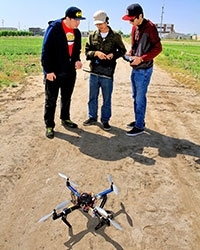Professor YangQuan Chen has many reasons to be proud of his Mechatronics, Embedded Systems and Automation (MESA) Lab.
Besides being extremely popular — so popular the lab has to turn away applicants — the lab now has nine Federal Aviation Administration certificates to fly unmanned aerial vehicles around the Central Valley.
But perhaps the best reason is the success of the students, who are being recognized and honored for the work they do in the MESA Lab. Here are just a few examples from this spring and summer.
 Graduate student Tiebiao Zhao, center, and other students work on precision agriculture projects.
Graduate student Tiebiao Zhao, center, and other students work on precision agriculture projects.
Graduate student Tiebiao Zhao, lab manager Brandon Stark and undergraduate researcher Jacqueline Clow took third place in the Food Systems Innovations category at the annual Berkeley Big Ideas competition.
Their “Low Cost Scientific Data Drones for Enhanced Melon Productivity and Security” project, also known as the SmartMelonDrone, uses software the team developed on low-cost unmanned aerial vehicles (UAV) to help manage the quantity and quality of melon produce.
Zhao, whose Ph.D. work is in precision agriculture, said he and his colleagues are working with the UC Merced branch of the Center for Information Technology Research in the Interest of Society (CITRIS) on commercialization.
The UAV platform uses multispectral imaging and image post-analysis software to detect nitrogen stress and water stress, monitor pests, estimate yields, monitor small-animal activity and more, to provide information to growers so they can make more informed decisions about field management.
“We want to help farmers save water and be better able to understand what is happening to their crops,” Zhao said. “There are so many opportunities in precision ag, especially here. We’re just trying to help.”
Stark and graduate student Brendan Smith won a $1,000 award from the UC Merced Natural Reserve System for using UAVs to map the Merced Vernal Pools and Grassland Reserve, the protected land adjacent to campus.
The mapping project, which continued through the summer, is creating an elevation model of the more than 6,500 acres for monitoring and predicting where the rare vernal pools will form.
Using high-resolution cameras, the drone can take pictures of every square inch of the reserve.
“There are still a lot of areas out there that we have not seen,” Stark said. “We’ve already made some interesting discoveries. For example, we found places where it’s possible someone had tried to cultivate the soil for growing crops.”
The cameras are so powerful, the pictures even reveal ground-squirrel burrows.
Stark also won an Interdisciplinary Small Grant from the Graduate Division for work with Professor Nicola Lercari, a faculty member in the School of Social Sciences, Humanities and Arts.
“We’re helping to preserve cultural heritage sites by combining terrestrial laser scanning in 3-D, and adding drones to the project so we can cover bigger areas and hard-to-reach areas,” Stark said.
Stark was also named Outstanding Graduate Student for 2015 by the Margo F. Souza Student Leadership Center.
Undergraduate researcher Garrett John took first place in the Research Week 90-Second Video Challenge for his pitch for air quality control using drones to sample for the pathogen that causes Valley fever.
And Huong Phan and Benjamin Bocanegra, undergraduates, won first place in the School of Engineering Undergraduate Student Poster Competition, first place in the Mobile App Challenge Best in Health category, and second place overall in the challenge for her project called SpineWatch. Phan worked on the hardware portion of the project, while Bocanegra designed the mobile app.
SpineWatch uses sensor technology embedded in a vest to monitor the spinal health of the wearer, specifically to warn against movements that can contribute to back problems or further complications from scoliosis, a spine-curvature issue that is often diagnosed in teenage girls.
Phan, inspired by her own experience with scoliosis, said her vest was the result of trying to figure out how best to correct posture. She considered 3-D printing a corset that girls could wear to keep their spines supported, but decided a soft, washable vest that alerts them about various movements might work better.
“It uses a mobile app, so the wearer can decide how he or she wants to be alerted,” she said. “I’d love to take it to hospitals and clinics for people with back problems, or prevent scoliosis in young girls by helping them monitor their movements.”



